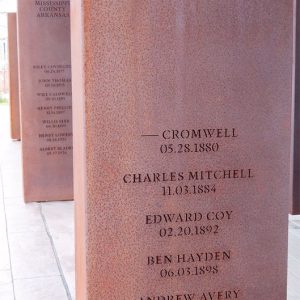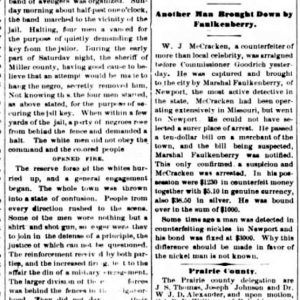calsfoundation@cals.org
Texarkana Race Riot of 1880
In late May 1880, racial unrest often described as the Texarkana Race Riot erupted in Texarkana (Miller County). Some newspapers, including the Arkansas Gazette, compared the event to the 1874 Brooks-Baxter War in Little Rock (Pulaski County), which centered around the contested gubernatorial election between Joseph Brooks and Elisha Baxter.
According to newspaper reports, the trouble started as a land dispute between an African-American man identified only as Dr. Cromwell and a white railroad worker named Conner. According to the 1880 census, railway employee James Conner was living in Miller County with his wife, Sarah, and three small children. The census was taken in June that year, and at the time there was an African-American man named Robert Cromwell, a fifty-year-old native of Wisconsin, housed in jail in neighboring Hempstead County. It is assumed that this is the Dr. Cromwell mentioned.
The Tri-Weekly Herald of Marshall, Texas, gives the most detailed account of the dispute between Conner and Cromwell. According to its report, Cromwell and Conner owned adjoining land, and Cromwell had erected a fence on Conner’s property. Conner tore up the fence, and Cromwell responded by attacking Conner with a club. Conner’s wife heard the attack and ran out to give her husband a gun. Conner shot at Cromwell and missed, and Cromwell escaped. He was later arrested but was freed on bond. On the morning of Saturday, May 29, Cromwell returned to Conner’s house, but found only Sarah Conner at home. According to the Dallas Daily Herald, Cromwell found her milking a cow in an alley. He attacked her, “tearing her clothing literally off,” but her screams roused the neighbors, and he fled. He was again arrested, and Sheriff J. A. Roberts, fearing trouble, hid him in an unknown location. That night, between thirty and sixty men, not knowing that Cromwell had been moved, descended on the jail intending to lynch him.
The jail was surrounded by African Americans who were hiding behind nearby fences. Four members of the mob approached the jail to demand the key and, when ordered to stop, refused to do so. The Chicago Tribune, in a special report that apparently came from the Arkansas Gazette, published a vivid account of the melee: “The reserve force of whites hurried up and a general engagement began. The whole town was thrown into a state of confusion. People from every direction rushed to the scene. Some of the men wore nothing but ‘a shirt and a shotgun,’ so eager were they to join in the defense of a principle.” As both parties received reinforcements, the “firing lent to the affair the din of a military engagement.” When the mob was ordered to charge, “the old War yell was raised, and the colored people stood for a moment, fired spasmodically, broke ranks and fled.” Members of the mob followed, shooting at any African American they encountered. While no white men were injured, the Tribune estimated that five African Americans were wounded, with three expected to die.
Subsequently, a large number of Black men reportedly came into town from the nearby countryside and threatened to burn the Arkansas side of Texarkana. White residents, hearing of this, armed themselves in preparation for an attack. According to the Arkansas Democrat, local residents appealed to Governor William Read Miller for protection, citing the threat to their lives and homes, and the fact that the prisoner would soon be back in Texarkana for examination. Miller replied that Sheriff Roberts had not called for his assistance and that he was powerless to act. No attack materialized. While the Chicago Tribune and the Arkansas Gazette reported that Cromwell had been found near the railroad tracks where Sheriff Roberts had hidden him and been hanged, this was not the case. Cromwell was brought back to town, waived examination, and was taken to the Hempstead County jail.
By June 1, peace had returned to Texarkana. However, the Gazette reported the next day that “unless [Cromwell] remains away from the vicinity of his attempts at outrage, his death is only a matter of condensed time. The people of Miller County are as warm-hearted as the sun which shines on them, but as determined in action as they are warm-hearted.”
For additional information:
“All Quiet.” Arkansas Democrat, June 1, 1880, p. 1.
“Attempt to Lynch a Negro Fiend at Texarkana.” Dallas Daily Herald, June 1, 1880, p. 1.
“Criminal News: A Party of White Lynchers Assailed by Negroes at Texarkana, Ark.” Chicago Tribune, June 1, 1880, p. 5.
“Local Paragraphs.” Arkansas Gazette, June 2, 1880, p. 5.
Untitled. Tri-Weekly Herald (Marshall, Texas), June 5, 1880, p. 2.
“War in Texarkana.” Arkansas Gazette, June 1, 1880, p. 8.
Nancy Snell Griffith
Davidson, North Carolina


 Miller County Lynching
Miller County Lynching  Texarkana Race Riot Article
Texarkana Race Riot Article 



Comments
No comments on this entry yet.